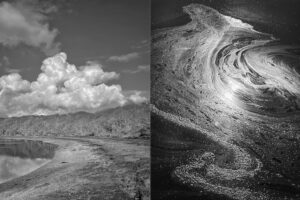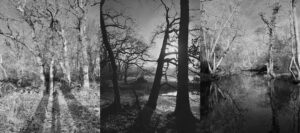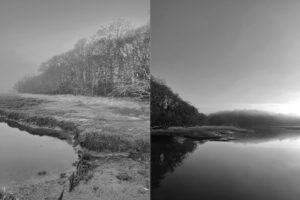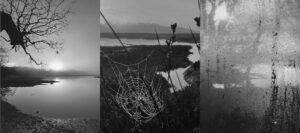The first (and second) butterfly of the year offer Mark Mattock the possibility of resurrection, rejuvenation, metamorphosis.

February slipped into March. Warnings and promises.
“My life is here, where soon the larks will sing again, and there is a hawk above. One wishes only to go forward, deeper into the summer land…” — J. A. Baker, The Hill of Summer, 1969
A cloud of pollen suddenly wafts from the bare hedge out into the path in front of me, as if I’ve just stumbled on smoker’s corner; I could almost hear the coughing. The wriggling larval lambs’ tails quickly resuming listlessness as if fearing attention, as I pass through the sylvan sperm cloud. Up until that point, along the hedge, catkin world was hanging limp, flaccid and heavy, dribbling pollen into the dead stillness. Like old wet socks hung out to dry on a garden rotary hanger, colours long lost in endless washes. A long horizontal branch is still gently rocking itself back into place after having been temporarily eased from it by the weight of the unseen hawk that the warning notes of blue tits and long tailed tits are still telling me it was. The ephemeral pool of predacious energy like the swirling turbulence on a glassy water surface, as molecular tension returns as efficiently as possible to equilibrium following the hasty departure of the huge bass that was hiding in ambush in the bladder wrack, that saw you before you saw it. Ghost hunters, signs, super senses, blown opportunities.
At well spaced intervals snow globes of blossom — cherry and very early blackthorn — like frozen flurries, create the only other sensation of motion in the naked hedgerow. A red admiral passes overhead, glides down the path, turns abruptly as if it had suddenly spotted the exact flower among the blinding blossom white-out it had been searching for. The whole bush glares, radiates, a discernible insect-activating warmth as I watch the spectacular insect supercharge; converting sun beams into power via its solar-panelled wings and syphoning high energy propellent — nectar — through the impossibly micro-engineered tubing of its proboscis.
First butterfly of the year has always carried significance. And once again the unconscious sudden intake-of-breath thrill at the sight of what is now the second of the species already this year, is tinged with pessimism. Yet again, it’s not the passing smiley day-glo yellow male brimstone, until recently the most likely first encounter. Watching the alarmingly striking creature with the warmth of the sun on the back of my bald head in the portentous calm of a classic early spring midday, I unfortunately cannot deny it looks like some ominous little nazi flag pin. A warning. With its fresh-spilt-blood red bands on the jet black velvet, trimmed with white brocade epaulettes, unmissable in the pure icing white surround. The only substantially red marked European butterfly once nostalgically synonymous with the Indian summers of back in the day: the single insect resting on the white goal posts visible even from the other end of the playing field. Or late afternoon sunning on the dry flaking boles of fragrant pines, or gathered around a sap bleed; or stumbling totally pissed with wasps on the fermented ooze of rotting plums, or competing with honey bees on the ivy blossom on heavily clad sun-soaked walls. Its numbers having built up over the course of the summer, descendants of the hardy migrants that made it across the channel weeks earlier. That would ultimately, it was thought, be wiped out by the miserable British winter, too cold for them to survive hibernation like their vanessid genus relatives: peacocks, tortoiseshells and commas. Recently it’s been discovered that many do return south. But now red admirals in February, hibernating comfortably, able to wake periodically if warm enough. A four-fold population increase with last year being unprecedented for them. It will always be a favourite.
Vanessa Atalanta is the most commonly depicted butterfly in western art. In the highly encoded vanitas still life paintings of the seventeenth century Dutch Masters, where butterflies depict the soul as Psyche — the winged maiden of classical greek, psyche being the word for soul and butterfly — the blood red and black, unlike the ephemeral lightness of everyday Cabbage Whites, is a reminder of mortality. The possibility of resurrection, rejuvenation…metamorphosis.
I didn’t get back to the cabin during the rest of the month — after four years covid finally caught up with me.

Crossing furze land, first days of March. Stonechat males chat like tapping stones three sixty degrees. On nearly all of the tallest yellow-flecked bushes sits a cocky little black-headed, white-collared, rust-stain-breasted sentinel. Fuzzackers (Dartford warblers), pipits — Tree and Meadow, and I really can’t tell the difference; woodlarks and skylarks — I just about can. Song thrushes in spindly silver birch tops, wheezing greenfinches, ‘chekking’ fieldfares, tzeeping redwings, warbling blackbirds; full on, full volume, acid heath avian rave. Spring. Early and late birds.
But I’m seriously struggling. This February had ten times the rainfall of last, unprecedented. A whole macerated landscape stretches out before me. Drenched. Water water everywhere. It’s impossible to plot a straight route in the New Forest at the best of times, but now my regular path to the cabin — the straightest possible — is impossible. Constantly having to detour. In the woods it’s all cajun swamp, where the oaks have morphed into the giant lichen-cloaked cypresses rising from the glassy tannin-blacked waters. I’m sweating like a hog, sloshing mostly ankle-deep across the acid heath Everglades, each step sounding like a slapped wet mop on a kitchen floor. Pony tracks are now bayous, puddles have become pools, pools ponds, ponds lakes; all spilling into each other, beaded on a loose network of trickling, some rushing, brooks and streams. All the way to the horizon the ground littered with what looks like the shining peelings and shavings of the blue sky and dumped glass coffee table tops and wall mirrors. My Meindls have been breached. I eventually find the road and cross it into charcoal forest. Literally. A new huge area of totally burnt gorse. I can’t tell whether it was deliberate or accident. I’ve stepped from deep south swampland into the scorched outback, crossing continents in just a few steps. Into a surreal forest of head-high bushes — bundles of black charcoal sticks that tinkle musically in the gentle breeze. Not a speck of spring green. It doesn’t escape me that this scorched and sodden, burnt and soaked landscape paradox is screaming the obvious. It’s looking like it’s going to be the warmest February on record.

I don’t go to the jetty straight away, simply slide open the glass door and sit just inside. Hands cupped tight around the hot coffee mug. I have no wish to do anything other than just stare at the approaching dawn after a very cold but cozy night. Directly out front a big toenail clipping moon sits slightly leant back, shining bright, in the faint orange pre-glow of a sun still well below the horizon. Weighty in the cold pure air above the thin fog bank, its pin-sharp reflection dead still on the immaculately polished blue-black steel water surface of the imperceptibly slow flooding lagoon. The far southern and eastern oak banks fade in and out as the pink washed fog drifts around the marsh, toying with perception of distance and space. Ice coats the leaf litter and dusts the jetty and footbridge. Disproportionately loud piercing peeps of irate oystercatchers racing low over the marsh suddenly smash the brittle tranquility. A blackbird starts chinking metallically. A single lone dirty foam clot, the colour of cappuccino froth, drifts with the entitlement and grandeur of a giant iceberg into the scene, floating slowly across the calm untroubled waters of the bay. As the light increases the fog vanishes and the waning crescent moon dissolves into the blue. From the unknown somewhere beyond comes the incessant caws of a distant rookery. Never surprised how far sound can amplify and travel in a space like this.
The cold burning sun, that moments ago was peeping through the stripped naked crowns, has lifted itself free, bleaching to a blinding primrose yellow as it rises. The droplet-laden stunted little hawthorn out front lights up to become a fallen chandelier of refracting prisms, with sequences of individual orbs of crystal wet exploding into iridescent splinters as I tilt my head from side to side. Suddenly a dabchick appears, replacing the foam clot out in the bay. It slips repeatedly through the looking-glass with liquid ease, leaving me guessing where it’ll re-emerge. Polly dishwater (pied wagtail) suddenly charges along the full length of the iced footbridge, stops dead, and bounces exuberant. Several drumming woodpeckers tuning their xylophonic strips of oakwood up in the canopies near and far.
The relentless and monotonous chink chink of the cock chaffinch above me is now quite grating. I finally get up to go have a smooch around. Frosty cold night again. Sun pops up deep orange over the crowns. Beaming the first direct rays across the marsh and into the oaks, and cabin. On the horizon giant billowing pink cumulus congestus. Everything is still sodden, saturated, and now with colour. In the red spectrum everything glowing intensely warm but yet without heat. The soaked dark wood stain umbers and mahoganies of the oak boles and boughs now glow russet, rust and rouge. The oak tops flush fox red as re-energising sap has clearly reached every twig, pushing on every bud. The lichen smothering the boundary edge trees is almost bioluminescent. The engorged verdant coral-like mounds of star mosses, feather mosses, and micro rainforests of pixie cup lichen, on the slopes of old rotting stumps, echo the intense algal green re-upholstering of the mud banks out on the marsh. Lawns of stiff dark green needles re-emerging along the flat rush beds in the no man’s land between mud and wood proper. Among the old dry taller sedge heads, still standing, glistening microscopic droplet-beaded orb webs wobble fluidly, only just released from icy stiffness, like lost string vests of last summer’s boat parties. When were they spun, how long have they hung there, intact in such an exposed position?

The sheer pain in my frozen fingertips and sodden toes as warm blood reaches them means I don’t have to pinch myself at the awe of it all. As the cold waterlogged landscape absorbs the incoming solar radiation everything begins to steam. Convection creating an eerie volcanic landscape where the mud mounds and huge oak boles now steam like hot joints of lamb. The footbridge looks as if it’s burning, the jetty is steaming, the deck is steaming. Across the bay only the highest branches in the eastern crowns definable, like antlers of escaping stags in the columns of glowing steam. It all looks likes the smouldering doused aftermath of some cataclysmic forest fire.
Squat on the now floating jetty, spellbound by swirling silk sheens of shining scum in the delicate transcendent vortices on the dark water surface, mirroring the unseen galaxies beyond the flawless blue abyss above. A billion billion sunlit particles bound by the same laws of the universe manifest as floating nebulae of cosmic dust on another scale. The reflection of a soaring kite emerges from the celestial raft. I look up to confirm. The bird not yet a common sight here.
By late morning all is clear, bright, crisp, and much warmer. High over the salt marsh mewing buzzards — the resident gang of five — indulge in grand gesturing aerial display: mock crashing into each other, spectacular speed stoops through hundreds of feet of brilliant sky, at the bottom of which the protagonist male pulling out and baring his chest triumphantly to the sun as he rises using the momentum, returning to the thermal column when it’s spent.
I crouch at the foot of a tall young oak, just squeezing into its hard dark shadow, which leads away from me across the blazing bright leaf litter towards where the female goshawk is calling from. Clearly caught in the invisible cone of allurement and menace emanating down from the nattily handsome male circling above. I can’t find her in the dazzling lattice of sun-bleached branches. He crisscrosses the fragments of blue in big wheels, in silence, not answering her. Teasing. His fine intricately barred breast radiant against the blue. His deep burnished grey back flashing like wet slate when he angles round on the far edge of his concentric circles. Every now and again a short blast of his round powerful wings, each primary shimmering. From under his pronounced white brow a burning eye beams the fiercest laser sharp stare. He sees me. A second female calls from the distant eastern oak bank. Mate, I really wouldn’t want to chance crossing a female goshawk!
It takes me a good while to finally actually see what is causing disturbances. Invisible creatures in the riffling shallows under the footbridge: puffs of silt, ripples, three drop splashes. It’s gobies, mini gobies, and once I finally see them I also notice the small crabs. Welcome sight, they’re all bass prey. Soon then. I encounter a similar phenomena the following day crossing the dew-velveted greens to the shops. In the shimmer I spot the odd pied wagtail, that I’d expect, but there is considerably more movement without source or cause, all over. Then, after closer attention, like with the gobies, they materialise. For every dishwasher I initially see there are another ten, twenty. A hundred to a hundred and fifty polly dishwashers moving in the shimmering green like a loose shoal of aquarium tetras. Short bursts of motion: a bob, a bounce of tail, a short surge forward, stillness again; repeated sporadically and randomly all over the wild lawns.
Eyes watering, tears skitter over my cheeks towards my ears, biting, burning cold easterly, as I watch the sun being thrust through the Eastern oaks and out into the amber-flushed haze above. The lagoon’s choppy water surface has shattered and stretched its burning reflection so it looks like the roaring exhaust flame blasting from the afterburners of a spherical rocket rising heavenward from Florida’s Cape Canaveral. Dawn of another day. Beginning of another year of cabin fever.
*
Mark Mattock. Artist. Photographer. Publisher. Rabbit Fighter. @the_rabbit_fighters_club